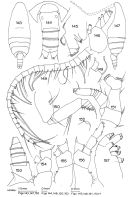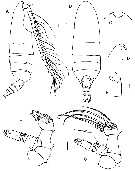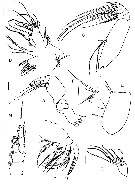|
|
 |
Fiche d'espèce de Copépode |
|
|
Calanoida ( Ordre ) |
|
|
|
Clausocalanoidea ( Superfamille ) |
|
|
|
Aetideidae ( Famille ) |
|
|
|
Crassantenna ( Genre ) |
|
|
| |
Crassantenna comosa Bradford, 1969 (F) | |
| | | | | | | Ref.: | | | Bradford, 1969 b (p.493, Descr.F, figs.F); Bradford & Jillett, 1980 (p.29, figs.F, Rem., distribution chart); Markhaseva, 1996 (p.144, figs.F); Markhaseva & al., 2017 a (p.30, Redescr., Rem.) |  issued from : J.M. Bradford in N.Z. Jl Mar. Freshw. Res., 1969, 3 (4). [p.494, Figs 143-157]. Female (from N New Zealand: E of North Cape): 143, habitus (dorsal); 144, urosome (dorsal); 145, Mx1; 146, Md (mandibular palp); 147, habitus (lateral left side); 148, A1; 149, P1; 150, Mxp; 151, A2; 152, forehead (ventral view); 153, urosome (lateral left side); 154, P2; 155, P3; 156, P4; 157, Mx2. Nota: Cephalothorax more than 3 times longer than urosome. Rostrum present as a blunt plate. Posterior corners of last thoracic segment upturned backward. A1 reaches thoracic segment 5. A2: exopod almost as wide as endopod, exopod segment 1 without setae but with 2 lumps. Mx1: inner lobe 2 with 4 setae, inner lobe 3 with 2 setae.
|
 Crassantenna comosa Crassantenna comosa female: Exopodal segment 1 of A2 without setae. 3rd internal lobe of Mx1 with 2 setae.
|
 Issued from : E.L. Markhaseva, J.M. Bradford-Grieve & J. Renz in Arthropoda Selecta, 2017, 26 (1). [p.31, Fig.3]. Female (from 43°58.44'N, 157°1829'E at depths 5418-5419 m): A-B, habitus (lateral and dorsal, respectively); C-D, rostrum (dorsal and lateral view); E, genital double-somite (lateral view of ventral part); F, G, A2 different views. Scale bars: A-B = 0/5 mm, remaining figures 0.1 mm. Nota: - Prosome 3.6 times as long as urosome. - Cephalosome and pediger 1 partly fused, pedigers 4 and 5 fused dorsally (holotype), or partly fused (Kuril Trench). - Posterior corners of prosome slightly upturned dorsally, reaching posterior third of genital double-somite, shorter in holotype; posterior corners, in dorsal view, pressed close to genital double-somite, buy not as close and shorter in holotype. - Genital double-somite with spermathecae directed dorsoanteriorly, with oval distal part (fig.3E). - Rostrum as a blunt plate. - Caudal rami with 4 terminal, 1 ventral, and 1 dorsolateral setae (setae either broken or represented by a scar at the location of insertion. - A1 24-segmented, reaching pediger 5; setae mostly pseudoannulate and not plumose. - A2: coxa, basis and exopod slightly longer than endopod, setal formula 0, 0-1-1, 1,1,1,1,1,3; endopodal segments wide (wider than exopodal segments), segment 1 with 1 seta, segment 2 with 7 large outer terminal setae (6 in holotype), ande 8 inner subterminal setae (1 shorter, 2 inner setae very small).
|
 Issued from : E.L. Markhaseva, J.M. Bradford-Grieve & J. Renz in Arthropoda Selecta, 2017, 26 (1). [p.32, Fig.4]. Female: A, Md; B, Mx1; C, Mx2 without endopod; D, endopod of Mx2; E, Mxp syncoxa; F, Mxp coxa with sensory appendage marked by arrow; G, Mxp basis and endopod; H, P1. Scale bars = 0.1 mm. Nota: - Md: basis without seta; exopod 5-segmented, setal formula 1, 1, 1, 1, and 2 setae ; endopod segment 1 with 1 seta, segment 2 with 4 setae; gnathobase with 7 teeth, 3 small (in holotype these are sharp and narrow and almost as long as other teeth and, adjacent to the base of articulated seta, long setules situated at base of 3 sharp teeth). - Mx1: praecoxal arthrite (1st inner lobe) with 9 terminal, 3 (2 setae in holotype) posterior and 1 anterior setae; coxal endite (2nd inner lobe) with 4 setae, proximal basal endite (3rd inner lobe) with 3 (2 setae in holotype) and distal basal endite with 4 setae; endopod with 15 (4, 3 and 8 setae in holotype), segments 2 and 3 separate); exopod with 11 setae; coxal epipodite (opposte to the arthrite) with 7 long plus 2 short setae (damaged in holotype). - Mx2: all endites with 3 setal element; ptaecoxal to basal endites with yufts of spinules; endopod with 6 setae. - Mxp: praecoxal endites of syncoxa with 1, 2 and 3 setae (from proximal to distal, proximal seta broken in holotype), coxal endite of syncoxa with 3 setae and sensory appendage visible on one limb of Kutil specimen §fig.4F), althrough difficult to observe on the other mounted limb of Kuril specimen, basis with 3 medial setae; endopodal segment 1 without setae, not visible in Kuril specimen and holotype setal formula 0, 3, 3, 3, 3+1, and 4 setae. - P1: coxa without seta; basis with very small distolateral seta, medial distal seta curved; endopod 1-segmented, lateral lobe developed, spinulated; exopodal segments 1, 2 and 3 with 1 lateral spine each; lateral spine of exopodal segment 1 extending to base of 2nd exopodal segment lateral spine, extending to mid-length of exopodal segment 3, this lateral spine shorter than preceding spines. - P5 absent.
| | | | | Ref. compl.: | | | Bradford-Grieve, 2004 (p.284) | | | | NZ: | 2 | | |
|
Carte de distribution de Crassantenna comosa par zones géographiques
|
| | | | Loc: | | | SW Pacif. (NE New Zealand). NW Pacif. (Kuril Trench)
Type locality: 34°56' S, 175°23 'E. | | | | N: | 2 | | | | Lg.: | | | (230) F: 3,7; (1214) F: 3,70; {F: 3,70} | | | | Rem.: | hyperbenthique (± 1385 m).
Voir aussi les remarques en anglais | | | Dernière mise à jour : 01/04/2018 | |
|
|
 Toute utilisation de ce site pour une publication sera mentionnée avec la référence suivante : Toute utilisation de ce site pour une publication sera mentionnée avec la référence suivante :
Razouls C., Desreumaux N., Kouwenberg J. et de Bovée F., 2005-2025. - Biodiversité des Copépodes planctoniques marins (morphologie, répartition géographique et données biologiques). Sorbonne Université, CNRS. Disponible sur http://copepodes.obs-banyuls.fr [Accédé le 04 juin 2025] © copyright 2005-2025 Sorbonne Université, CNRS
|
|
 |
 |






